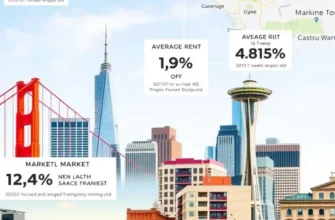Relocating to a new city can be thrilling yet daunting, especially when it comes to finding the right apartment. With varying rental markets and peak seasons across major cities, timing your search can make all the difference. For young professionals, students, couples, families, and mobile professionals alike, knowing when to look for rentals can save you time, money, and frustration. This guide will explore the distinct peak seasons for apartment rentals in key U.S. cities, helping you navigate your transition smoothly. Whether you’re chasing vibrant city life in New York, tech opportunities in San Francisco, or the charm of Austin, understanding the rental landscape will empower you to make informed decisions. Let’s dive into the rental trends and local tips that will serve you best in your apartment journey.
Understanding Peak Apartment Rental Seasons

When looking to rent an apartment, timing can be a crucial factor that affects both availability and cost. Each major U.S. city has its own peak rental seasons, influenced by factors like climate, local economy, and academic calendars. Understanding these can help renters, from students to professionals, find their ideal apartment at the best possible time.
Many cities experience significant market fluctuations based on seasonal demand. For example, metropolitan areas with large student populations, such as Boston and Austin, see peaks in the rental market in late spring and summer. This is when students seek housing for the upcoming academic year. As these cities attract thousands of students, competition becomes fierce, driving up rental prices.
In contrast, warmer climates like Miami often experience rental surges in the winter months. Snowbirds and retirees flock to escape the colder weather elsewhere, creating a spike in demand from October through February. This migration impacts the availability of apartments, making it a less ideal time for locals to secure affordable housing.
For young professionals and families relocating due to job opportunities, the spring and early summer months are prime. Many leases end around this time, increasing the inventory of available units. However, this period can also lead to increased competition. It’s crucial for renters in this demographic to act quickly when they find a desirable listing.
Cities with dynamic job markets, like San Francisco and New York, exhibit year-round demand with subtle shifts between different neighborhoods and boroughs. Renters here might find better deals during winter months when fewer people are likely to move due to harsh weather, leading to slightly decreased competition.
In choosing when to search for an apartment, considering personal circumstances alongside these regional trends is important. Students might prioritize proximity to campus, while families look for school district ratings. Professionals may be willing to pay a premium for shorter commutes. Assessing these priorities against seasonal market trends can uncover the best times to search for an apartment.
In some cities, rental prices are significantly lower during off-peak seasons. Renters might be incented to sign longer leases if properties remain vacant during slower periods. This is when negotiating reduced rates or added perks with property managers becomes feasible.
For those ready to take on the rental market, being strategic about timing can lead to benefits beyond cost savings. Use tools and resources to track seasonal trends, and consider advice from local rental guides like this one for apartments near the University of Texas. These insights can provide a clearer understanding of the best time to plan your apartment hunt, leading to successful and satisfying outcomes.
City-Specific Insights for Renters

Finding the perfect city apartment involves more than just budget considerations. Each U.S. city has unique rental trends shaped by various factors. Understanding these can help you time your apartment search to avoid peak rental periods.
New York City
The city that never sleeps offers a diverse rental market. High demand due to constant influxes of new residents and students means peak rental seasons are significant. The spring and summer months, specifically May through September, see the highest demand. New graduates and international students drive this surge, seeking accommodation before fall semesters begin.
San Francisco
San Francisco’s rental market is heavily influenced by the tech industry. Job cycles in the tech sector often cause two rental peaks: one in late winter and another in early summer. Expect high competition from new hires and interns around these times. If flexibility allows, consider apartment hunting in fall when the market typically cools.
Los Angeles
Known for its broad entertainment industry, Los Angeles experiences rental peaks aligned with project cycles. Late spring and summer attract those moving for new opportunities. For a softer rental climate, aim for the post-holiday season in January and February. Prices may slightly dip, and competition lessens as people settle back into routines.
Chicago
The Windy City’s rental market experiences fluctuations due to its harsh winters. Most renters prefer moving in the warmer months, with peak times from May to September. Educational calendars also play a role, especially around major universities. Affordable rentals are often available in early spring before the surge.
Austin
Austin stands out for its vibrant tech scene and music festivals. While rental peaks coincide with academic semesters, South by Southwest in March also influences demand. Summer remains the highest for rentals as students vacate and new residents arrive. A less competitive window is commonly found in early winter.
Seattle
Seattle’s rental scene is somewhat synchronized with its economic activities. The city’s tech hub status creates peaks in early spring and late summer due to hiring cycles. Winter months, particularly December, often present the best opportunities for lower prices and less competition.
Miami
Miami’s rental market ebbs and flows with tourist seasons. While tourism peaks coincide with winter months due to warmer weather, springtime also sees increased demand from new graduates. For fewer competitors and better deals, consider a move during Miami’s hurricane season in the fall.
Understanding city-specific rental trends can give you an edge in finding your ideal home. If exploring options beyond traditional renting, consider the pros and cons of co-living. The dynamic nature of city living requires staying informed and flexible to make the most of your rental experience.
Final words
Navigating the complexities of the rental market can be overwhelming, especially when relocating to a new city. By understanding the peak rental seasons and local trends, you can strategically plan your apartment search to ensure you find a home that fits both your needs and your budget. From the vibrant streets of New York to the laid-back charm of Austin, each city’s unique market dynamics present opportunities for informed renters. With careful timing and a savvy approach, your search can be less stressful and more successful. Embrace the journey ahead and make your next move with confidence!









